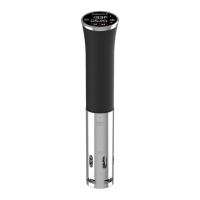3
Introduction
Ideal Foods for Sous Vide Cooking
Meats
Red meat: lamb, beef, venison, bison, and pork
Poultry: chicken, turkey, and duck
Seafood: fish, lobster tails, and scallops
Eggs
Vegetables
Root vegetables: potatoes, carrots, parsnips, beets, and turnips
Tender vegetables: peas, asparagus, corn, broccoli, cauliflower, eggplant, onions, and squash
Fruit
Firm fruits: apples, and pears
Tender fruits: mangoes, plums, apricots, peaches, nectarines, papayas, and strawberries
Food Preparation
• Start with fresh and high quality ingredients.
• Ensure that all meat, seafood, and poultry have been stored at below 5 °C or 41 °F. We
recommend using a digital food thermometer to check the temperature.
• Make sure that the food pouches are clean and that they’ve not been contaminated by dirt or
other food items.
• Use detergent and warm water, or a sanitizing solution to clean the food preparation area.
• To avoid any cross-contamination, ensure that the area used for raw ingredient preparation does
not come into contact with any cooked foods.
• Wash hands well before any food preparation.
Storage
If the food you have cooked is not going to be consumed immediately, plunge the pouch into ice
water to reduce temperature quickly. Keep refrigerated.
Ingredients & Seasonings
• Use the highest-quality and freshest ingredients available when cooking sous vide. The food
cooks in its own juice. You want to make sure the juice has the best possible flavor.
• When seasoning with salt, it is better to use a little less than you would to season foods cooked
by traditional methods, especially with meats, poultry, and fish. You can always season to taste
with salt after cooking.
• Use garlic powder rather than raw garlic, as raw garlic can become strong and bitter when cooked
sous vide. Make sure not to use garlic salt. Pure and high-quality garlic powder will provide better
results.

